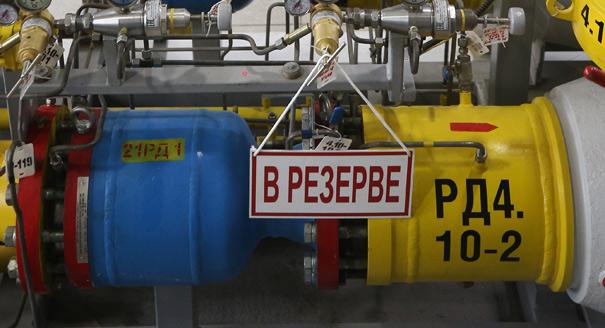It’s a trying time for the two pillars of Russia’s energy exports: oil and gas. The new coronavirus pandemic has shattered demand on traditional markets, especially in Europe.
Compared with the same day last year, electricity generation at gas-powered plants in northern Italy was down by 54 percent on the last Tuesday of March this year, by 37 percent in the Netherlands, and by 15 percent in western Germany. This is despite the fact that late March was colder this year in Europe than last year. One of the consequences of people staying at home rather than driving their cars and working from office buildings is a steep drop in demand for gas, totaling billions of cubic meters.
The gas market has seen low prices and an excess of liquefied natural gas (LNG) since the middle of 2019. According to forecasts by the International Energy Agency, gas production this year will reach a record of about 4 trillion cubic meters. Against this backdrop, the sharp fall in demand has sent prices into an uncontrollable tailspin.
On the European market, stock market prices for gas—i.e., those determined on virtual trading platforms based on supply and demand—are already below $80 per thousand cubic meters: levels unseen since 1999. For comparison, in central and southern Russia, Gazprom can get up to $65 at the current exchange rate per thousand cubic meters by selling gas to industrial enterprises, and a little less if it sells to the public. And that doesn’t entail the expense of transporting the gas to Europe and paying a 30 percent export tax.
The prices for Gazprom’s long-term contracts are for now up to double those of European stock quotes, and on its own export trading platform, Gazprom is keeping prices at $110 per thousand cubic meters, using long-term forward contracts for the autumn and next year, when the company expects gas to be more expensive. For now, this enables the company to keep supplying gas to Europe with a minimal profit margin.
Yet the Russian giant, which supplies more than one-third of Europe’s gas, is definitely feeling the strain. The company drew up its 2020 budget based on a price of $200 per thousand cubic meters. In January and February, it delivered gas at an average price of about $170 per thousand cubic meters, but the year’s average, taking into account the collapse of oil prices in March, will clearly be lower.
It’s also obvious that export volumes will be lower than Gazprom’s 200 billion cubic meter target. The volume of gas exported in January and February was already at least 20 percent lower than that of the previous year, and remained at that level in March. There’s no knowing yet how far European demand will fall over the next few months.
The slump in gas prices will create plenty of problems, but it could also provide a much-needed purging of an industry that in recent years has seen increasingly absurd projects unveiled for pipelines and LNG terminals. Many of those projects clearly fail to take into account that, in the long term, gas should be affordable, and preferably green, if it is to withstand the growing competition from renewable energy sources.
LNG supplies to the European market—mainly from the United States—doubled last year and continued to increase this year. At the current prices, newcomers to the market will be unable to pay back the multibillion dollar investment in their factories over the next decade at least.
Last month, Shell pulled out of the Lake Charles LNG project on the shore of the Gulf of Mexico, and the Australian company Woodside has postponed a range of LNG projects. This is undoubtedly only the beginning of a trend. Europe will also likely see an impact, including a holdup in developing new offshore gas fields on the Norwegian continental shelf, and an end to plans by some European countries to produce shale gas.
For Russia, this supercycle bear market won’t pass unnoticed either, but the Russian gas industry has always been more than simply a sector of the economy, so it’s unlikely to bring any radical reassessment of strategy. It may slow down the launch of production at new deposits and the construction of new infrastructure projects. But projects with a broad international element such as Gazprom’s Nord Stream 2 and Novatek’s Arctic LNG 2 have a greater chance of success because they bring together the interests of both gas producers and consumers.
Gazprom’s European customers risk failing to meet the take-or-pay clauses in their long-term contracts. This could mean they have to pay fines to the Russian company. But Gazprom will do well to show goodwill by rolling over the unused volumes to a later period: refusing to compromise with its customers while the market is overloaded and prices are falling runs the risk of the long-term loss of their loyalty.
At a time when gas prices are at their lowest in Europe since 1999, and lower than they have ever been in Asia, Russian gas producers have begun turning their attention to the domestic market. In theory, developing domestic demand—even at the current regulated prices—could generate revenues comparable with those brought in by Europe’s traditional markets. But there is a major risk of nonpayments, which will inevitably mount up as a result of the damage to the economy inflicted by the pandemic.
The most surefire strategy for the gas sector, therefore, is that used in all industries in times of crisis: radical cost-cutting and boosting efficiency. The gas industry managed to mostly avoid these measures in previous crises, but the current perfect storm simply leaves it with no other options.
This article is part of the Russia-EU: Promoting Informed Dialogue project supported by the European Union in Russia.



